We asked Leigh Neville, author of the forthcoming Modern Snipers and well known to Osprey readers for his books on modern warfare, to select his top five modern sniper rifles as the first of a series on modern sniping for the Osprey blog.
Choosing only five rifles was a difficult process as there are a lot of solid contenders with impressive combat records. In the end, I considered some of the most common and widely employed weapon platforms that have seen service in Afghanistan and Iraq with both conventional and special operations forces and selected from these.
The list is an intriguing mix of the new and old, although surprisingly most of the rifles are based, at least in part, on classic designs dating back to the 1960s. Both bolt action and semi-automatic platforms are represented, although the latter type is increasingly seeing favour over the former thanks to its ability to rapidly engage multiple targets. It can also be used as an assault rifle in extremis, for example should the sniper team find themselves forced to clear buildings.
I interviewed former Delta Force sniper John ‘Shrek’ McPhee for Modern Snipers, who agreed, explaining that he favoured the semi-automatic over the bolt action for most operational requirements; “There is not that much difference in accuracy. The (other) big downside to bolt guns is the delay between rounds. Lastly, it’s easier to stay inside the scope with a semi because your hands stay on the gun the entire time”.
Now, without further ado, here are my top five modern snipers!
Number 5: The HK417
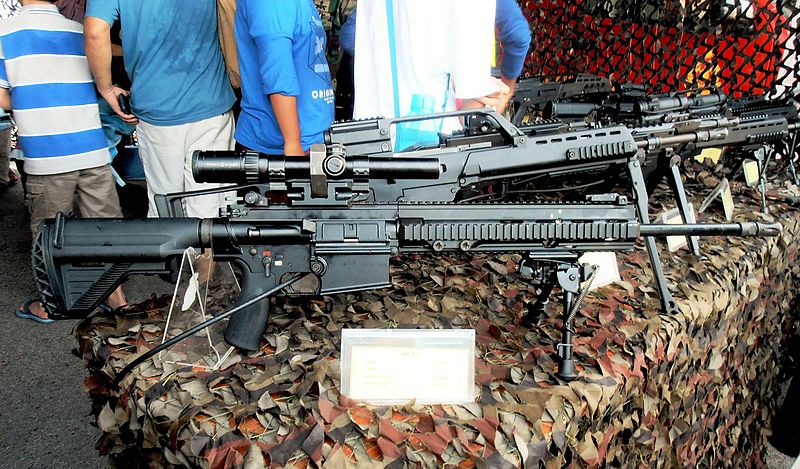
(Photo from Rizuan)
The 7.62x51mm Heckler and Koch HK417 was initially developed from the veteran AR-10 battle rifle as a larger-caliber ‘big brother’ to the widely successful 5.56x45mm Heckler and Koch HK416. The semi-automatic HK417 feeds from a 20-round magazine and is effective out to at least 600 meters in the right hands. The weapon is offered in a number of configurations from the short-barreled Assaulter model for special operations troops who need a compact but hard-hitting platform, to the 20-inch barrel sniper model.
Along with service in the German Army as the G28, the HK417 has served with SEAL Team Six and the British Special Forces Support Group, Danish and Norwegian snipers and designated marksmen and with the Australian Army in Afghanistan. The HK417 was also recently awarded the tender for the U.S. Army’s Compact Semi-Automatic Sniper System (CSASS) to replace the M110 (see Number 3) in a contract for some 3,600 rifles.
Number 4: The M40A5
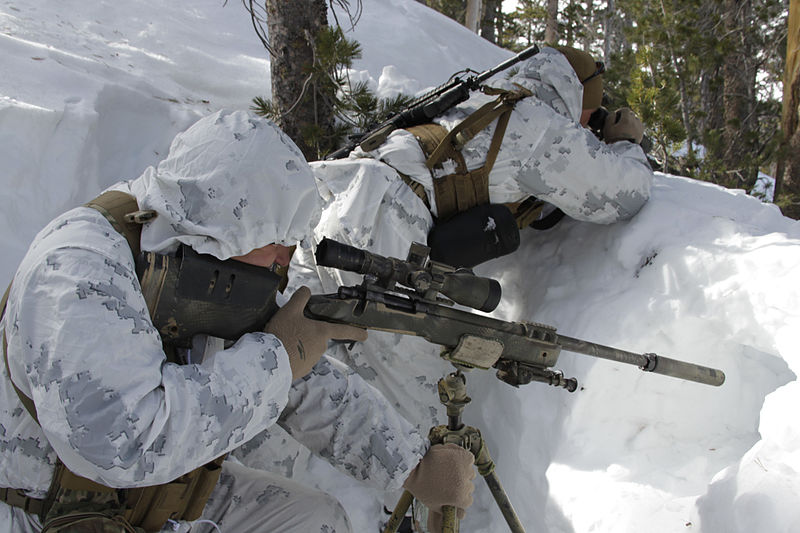 Snipers using a M40A5 with tripod and suppressor while training at the Mountain Warfare Training Center
Snipers using a M40A5 with tripod and suppressor while training at the Mountain Warfare Training Center
(Photo by Lance Corporal Sarah Anderson)
The U.S. Marine Corps’ Scout Snipers have deployed to war with versions of the bolt-action 7.62x51mm M40 since 1966. Based on the civilian Remington 700 hunting rifle design, the current M40A5 variant features a free-floating 24-inch barrel and a detachable ten-round magazine. Free-floating barrels help maintain consistent accuracy as they are only attached to the actual receiver of the weapon rather than the stock.
The M40A5 has served in every major and minor conflict where Marine snipers have been deployed and can reliably engage targets out to, and in some cases beyond, 800 meters. A new version is imminent that will feature a skeletonized stock, although the Scout Sniper community have been arguing for the adoption of a longer-range caliber like the .338 Lapua Magnum following their experiences in Afghanistan.
Number 3: The SR-25
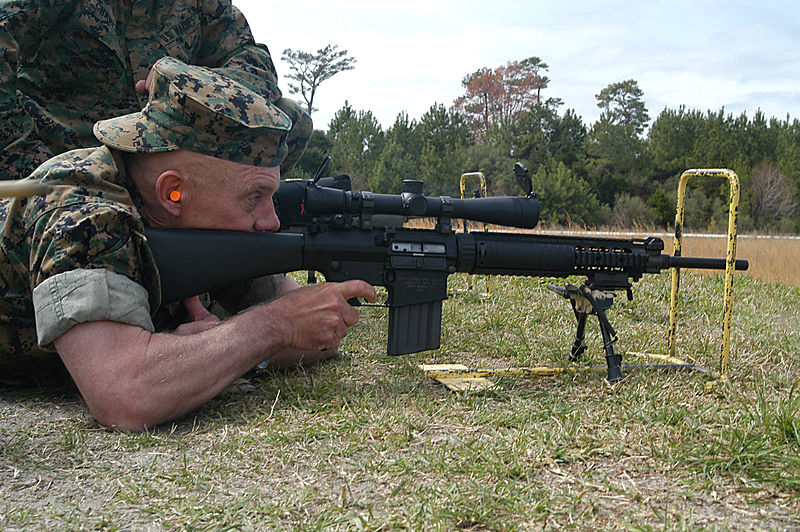 A U.S. Marine General fires the Mk 11
A U.S. Marine General fires the Mk 11
The Knight’s Armament Company SR-25 chambered for the 7.62x51mm round was initially developed in the 1990s for U.S. Army special operations forces who were looking for a longer-range and more modern platform than the M21 they had available, which was itself based on the Vietnam War era M14 battle rifle. The first SR-25s deployed to Somalia in 1993 but the weapon went through numerous iterations before it was adopted as the Mk11 by U.S. Special Operations Command in 2000.
The SR-25 is another AR-10 based design that feeds from a 20-round magazine. Effective range is between 600 and 800 meters. Unlike the later HK417, the SR-25 features no fully automatic selector setting but shares a similar free-floating barrel. It has been widely employed by all U.S. special operations forces including the Rangers and Army Green Berets, along with Polish and Australian Special Forces. A version of the SR-25 was adopted by the U.S. Army as the M110 Semi-Automatic Sniper System (SASS) in 2007.
Number 2: The M2010
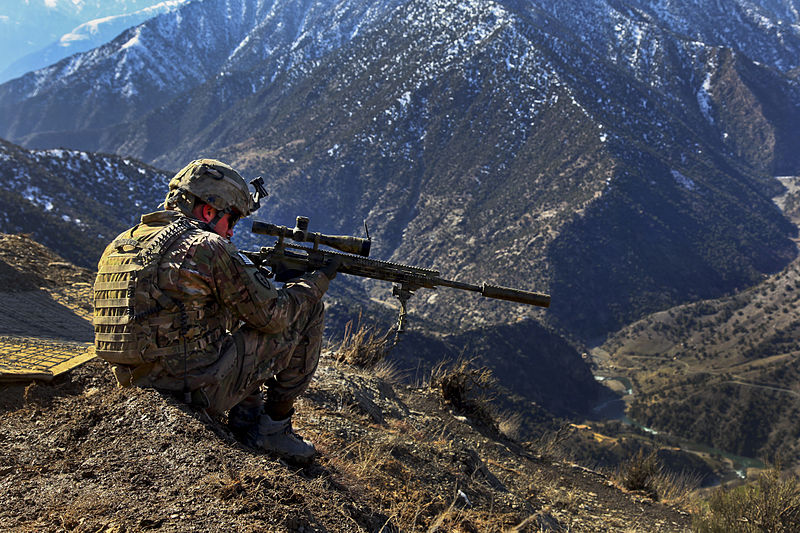 The M2010 in U.S. Army service in Afghanistan, February 2012
The M2010 in U.S. Army service in Afghanistan, February 2012
(Photo by U.S. Army Sgt. Trey Harvey)
The U.S. Army’s bolt action 7.62x51mm M24 Sniper Weapon System (SWS) has served since 1988 as the Army’s principal sniper rifle until supplemented by the M110. The latest version, the M24A2, was known as an exceptionally accurate rifle with hits recorded out to 1,000 meters in Afghanistan. Like the Marines’ M40A5, the M24A2 featured an aftermarket lightweight stock, a detachable 10-round magazine, folding bipod and the ability to quickly attach a sound suppressor.
Now the M24A2 is being slowly replaced by the M2010. With unusual forethought, the Army had insisted on the long-action variant of the Remington 700 action (rather than the short-action adopted by the Marines in their M40) when purchasing the original M24s. This longer action allowed a relatively straightforward conversion to a new, larger, caliber. Needing a longer-range caliber and instead of adopting a wholly new rifle, the Army simply upgraded the M24A2 with a new skeletonised stock, a 1-in-10-inch twist free-floating barrel (adding greater flight stability to the bullet) and a new calibre, the excellent .300 Winchester Magnum, which is effective out to 1,200 meters.
Number 1: The Arctic Warfare Magnum
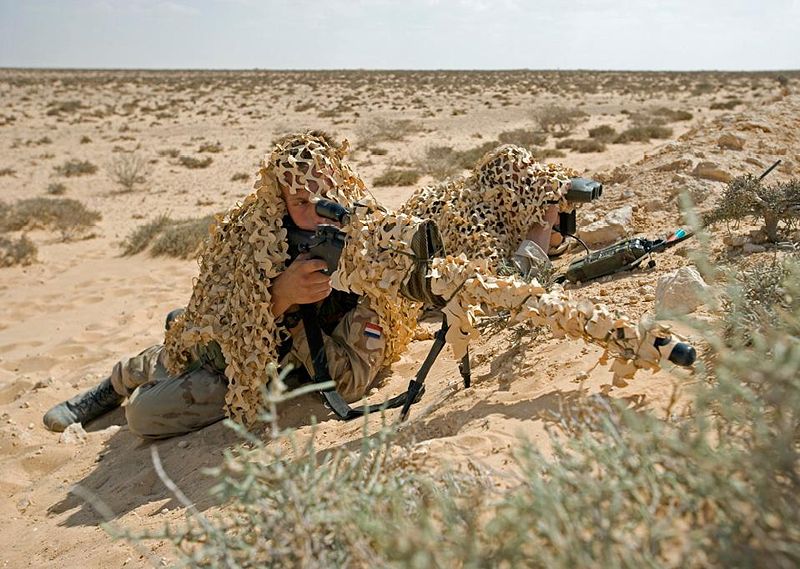 A Dutch ISAF sniper team using the Accuracy International AWM .338 Lapua Magnum rifle
A Dutch ISAF sniper team using the Accuracy International AWM .338 Lapua Magnum rifle
(Photo by Francis Flinch)
The Accuracy International Artic Warfare Magnum or AWM is a bolt-action sniper rifle chambered for the big .338 Lapua Magnum round. The AWM is a development of the company’s popular Arctic Warfare models in 7.62x51mm such as the British Army’s L96A1 and the Australian SR-98. Effective out to and beyond 1,500 meters, the AWM was first adopted by UK Special Forces before a wider adoption by the British Army in 2007, where the weapon is known as the L115A3.
The AWM offers the capability of first-round hits out to 1,100 meters with ten-inch groupings typical at this range which, in sniper parlance, translates as a sub-1 MOA or Minute of Angle rifle or in other words, bloody accurate! British sniper Craig Harrison achieved the longest-range known kill with the weapon in Afghanistan in 2009 at the incredible range of 2,475 meters. The ‘American Sniper’, the late Chris Kyle, also stated a preference for the .338 Lapua Magnum AWM. Today the platform, and its most recent version the AX338, is widely employed by both military and police counterterrorist units.
Modern Snipers, Leigh Neville's latest book, is publishing on 25 August 2016. Click here to preorder today.

Comments
You must be logged in to comment on this post. Click here to log in.
Submit your comment